Fano Resonant Sensing in MIM Waveguide Structures Based on Multiple Circular Split-Ring Resonant Cavities
Abstract
1. Introduction
2. Structural Modelling and Analytical Methods
3. Simulation and Analysis of Results
3.1. Analysis of the Rotation Direction of the CSRRC
3.2. Analysis of the Rotation Directions of the CSRRCs
4. Analysing the CSRRCs of Different Structural Dimensions
5. Conclusions
Author Contributions
Funding
Data Availability Statement
Conflicts of Interest
References
- Deng, Z.L.; Qiao, X.C.; Chen, Y.B.; Shi, T.; Li, X.; Dong, J.W. Lasing action in Fano-resonant superlattice metagratings. J. Phys. D Appl. Phys. 2021, 54, 345101. [Google Scholar] [CrossRef]
- Negahdari, R.; Rafiee, E.; Kordrostami, Z.; Rafiei, E. Sensitive MIM plasmonic biosensors for detection of hemoglobin, creatinine and cholesterol concentrations. Diam. Relat. Mater. 2023, 136, 110029. [Google Scholar] [CrossRef]
- Karmakar, S.; Kumar, D.; Varshney, R.K.; Chowdhury, D.R. Strong terahertz matter interaction induced ultrasensitive sensing in Fano cavity based stacked metamaterials. J. Phys. D Appl. Phys. 2020, 53, 415101. [Google Scholar] [CrossRef]
- Raghunathan, V.; Deka, J.; Menon, S.; Biswas, R.; A.S, L.K. Nonlinear Optics in Dielectric Guided-Mode Resonant Structures and Resonant Metasurfaces. Micromachines 2020, 11, 449. [Google Scholar] [CrossRef]
- Chen, H. Nanoresonator Enhancement of Majorana-Fermion-Induced Slow Light in Superconducting Iron Chains. Micromachines 2021, 12, 1435. [Google Scholar] [CrossRef]
- Lombardi, J.R.; Birke, R.L. A Unified View of Surface-Enhanced Raman Scattering. Acc. Chem. Res. 2009, 42, 734–742. [Google Scholar] [CrossRef]
- Yi, J.; You, E.M.; Ding, S.Y.; Tian, Z.Q. Unveiling the molecule–plasmon interactions in surface-enhanced infrared absorption spectroscopy. Natl. Sci. Rev. 2020, 7, 1228–1238. [Google Scholar] [CrossRef]
- Zhu, J.; Xu, Q.; Jian, Z. Novel high performance Fano resonance sensor with circular split ring resonance. Phys. B Condens. Matter 2024, 689, 416205. [Google Scholar] [CrossRef]
- Shao, L.; Wang, Z.; Mu, N.; Chen, T.; Zhu, W. Terahertz Metasurface with High-Q Fano Resonance for Bio-Sensing. IEEE J. Sel. Areas Sens. 2024, 1, 272–279. [Google Scholar] [CrossRef]
- Dayal, G.; Chin, X.Y.; Soci, C.; Singh, R. High-Q Whispering-Gallery-Mode-Based Plasmonic Fano Resonances in Coupled Metallic Metasurfaces at Near Infrared Frequencies. Adv. Opt. Mater. 2016, 4, 1295–1301. [Google Scholar] [CrossRef]
- Li, C.; Wang, M.; Wu, J.F. Broad-bandwidth, reversible, and high-contrast-ratio optical diode. Opt. Lett. 2017, 42, 334. [Google Scholar] [CrossRef] [PubMed]
- Shin, H.J.; Yoo, J.; Park, E.; Song, E.H.; Nam, J.M. Plasmonic Nanogap Probes for Surface-Enhanced Raman Scattering-Based Bioimaging and Analysis. J. Phys. Chem. C 2024, 128, 17815–17824. [Google Scholar] [CrossRef]
- Shi, X.; Ma, L.; Zhang, Z.; Tang, Y.; Zhang, Y.; Han, J.; Sun, Y. Dual Fano resonance control and refractive index sensors based on a plasmonic waveguide-coupled resonator system. Opt. Commun. 2018, 427, 326–330. [Google Scholar] [CrossRef]
- Zhang, X.; Yan, S.; Liu, J.; Ren, Y.; Zhang, Y.; Shen, L. Refractive Index Sensor Based on a Metal-Insulator-Metal Bus Waveguide Coupled with a U-Shaped Ring Resonator. Micromachines 2022, 13, 750. [Google Scholar] [CrossRef] [PubMed]
- Chou Chau, Y.F.; Ming, T.Y.; Chou Chao, C.T.; Thotagamuge, R.; Kooh, M.R.R.; Huang, H.J.; Lim, C.M.; Chiang, H.P. Significantly enhanced coupling effect and gap plasmon resonance in a MIM-cavity based sensing structure. Sci. Rep. 2021, 11, 18515. [Google Scholar] [CrossRef]
- Chen, J.; Lian, X.; Zhao, M.; Xie, C. Multimode Fano Resonances Sensing Based on a Non-Through MIM Waveguide with a Square Split-Ring Resonance Cavity. Biosensors 2022, 12, 306. [Google Scholar] [CrossRef]
- Cao, T.; Wei, C.; Simpson, R.E.; Zhang, L.; Cryan, M.J. Fast tuning of Fano resonance in metal/phase-change materials/metal metamaterials. Opt. Mater. Express 2014, 4, 1775. [Google Scholar] [CrossRef]
- Zhang, M.; Fang, J.; Zhang, F.; Chen, J.; Yu, H. Ultra-narrow band perfect absorbers based on Fano resonance in MIM metamaterials. Opt. Commun. 2017, 405, 216–221. [Google Scholar] [CrossRef]
- Chen, Y.; Li, M.; Zhang, M.; Ding, Z. Fano resonance characteristics of a silicon notched disk metasurface-waveguide system under different polarization conditions. Phys. Scr. 2023, 98, 025505. [Google Scholar] [CrossRef]
- Guo, P.; Du, H.; Li, J.; Li, S.; Li, H.; Yin, Z.; Li, Y. Study on a sodium-based broadband SPR dual-parameter sensor tuned with Ta2O5 thin films. Phys. Scr. 2024, 100, 015538. [Google Scholar] [CrossRef]
- Wang, X.; Zhang, J.; Zhu, J.; Yi, Z.; Yu, J. Refractive index sensing of double Fano resonance excited by nano-cube array coupled with multilayer all-dielectric film. Chin. Phys. B 2022, 31, 024210. [Google Scholar] [CrossRef]
- Korkmaz, S. Multiple ultra-narrow band-stop filters based on MIM plasmonic waveguide with nanoring cavities. Phys. Scr. 2024, 99, 035503. [Google Scholar] [CrossRef]
- Zhu, X.; Cao, N.; Thibeault, B.J.; Pinsky, B.; Yanik, A.A. Mechanisms of Fano-resonant biosensing: Mechanical loading of plasmonic oscillators. Opt. Commun. 2020, 469, 125780. [Google Scholar] [CrossRef]
- Sun, Y.; Qu, D.; Ren, Y.; Li, C. Nanorods-enhanced MIM plasmonic sensor based on S-shaped waveguide coupled with ohm-shaped and D-shaped resonators. Phys. E Low-Dimens. Syst. Nanostruct. 2024, 161, 115971. [Google Scholar] [CrossRef]
- Zonouri, S.A.; Basem, A.; Younis Al-zahy, M.A. Innovative MIM diplexer with neural network enhanced refractive index detection for advanced photonic applications. Sci. Rep. 2024, 14, 31473. [Google Scholar] [CrossRef]
- Qiao, L.; Zhang, G.; Wang, Z.; Fan, G.; Yan, Y. Study on the Fano resonance of coupling M-type cavity based on surface plasmon polaritons. Opt. Commun. 2019, 433, 144–149. [Google Scholar] [CrossRef]
- Zhu, J.; Wu, C. Optical refractive index sensor with Fano resonance based on original MIM waveguide structure. Results Phys. 2021, 21, 103858. [Google Scholar] [CrossRef]
- Liu, X.; Li, J.; Chen, J.; Rohimah, S.; Tian, H.; Wang, J. Independently tunable triple Fano resonances based on MIM waveguide structure with a semi-ring cavity and its sensing characteristics. Opt. Express 2021, 29, 20829. [Google Scholar] [CrossRef]
- Xiao, G.; Xu, Y.; Yang, H.; Ou, Z.; Chen, J.; Li, H.; Liu, X.; Zeng, L.; Li, J. High Sensitivity Plasmonic Sensor Based on Fano Resonance with Inverted U-Shaped Resonator. Sensors 2021, 21, 1164. [Google Scholar] [CrossRef]
- Wang, M.; Zhang, M.; Wang, Y.; Zhao, R.; Yan, S. Fano Resonance in an Asymmetric MIM Waveguide Structure and Its Application in a Refractive Index Nanosensor. Sensors 2019, 19, 791. [Google Scholar] [CrossRef]
- Ren, Y.; Sun, Y.; Qu, D.; Li, C. Double tunable Fano resonance based on a metal–insulator–metal waveguide with double coupled cavities and its application. Appl. Opt. 2024, 63, 5324. [Google Scholar] [CrossRef]
- Zhu, J.; Li, N. MIM waveguide structure consisting of a semicircular resonant cavity coupled with a key-shaped resonant cavity. Opt. Express 2020, 28, 19978. [Google Scholar] [CrossRef] [PubMed]
- Ren, X.; Ren, K.; Cai, Y. Tunable compact nanosensor based on Fano resonance in a plasmonic waveguide system. Appl. Opt. 2017, 56, H1. [Google Scholar] [CrossRef] [PubMed]
- Qi, Y.; Wu, Q.; Su, M.; Li, H.; Wang, X. MIM waveguide refractive index sensor with graphene enhanced three-ring nested resonator Fano resonance. Phys. Scr. 2024, 99, 075525. [Google Scholar] [CrossRef]
- Ren, X.; Ren, K.; Ming, C. Self-Reference Refractive Index Sensor Based on Independently Controlled Double Resonances in Side-Coupled U-Shaped Resonators. Sensors 2018, 18, 1376. [Google Scholar] [CrossRef]


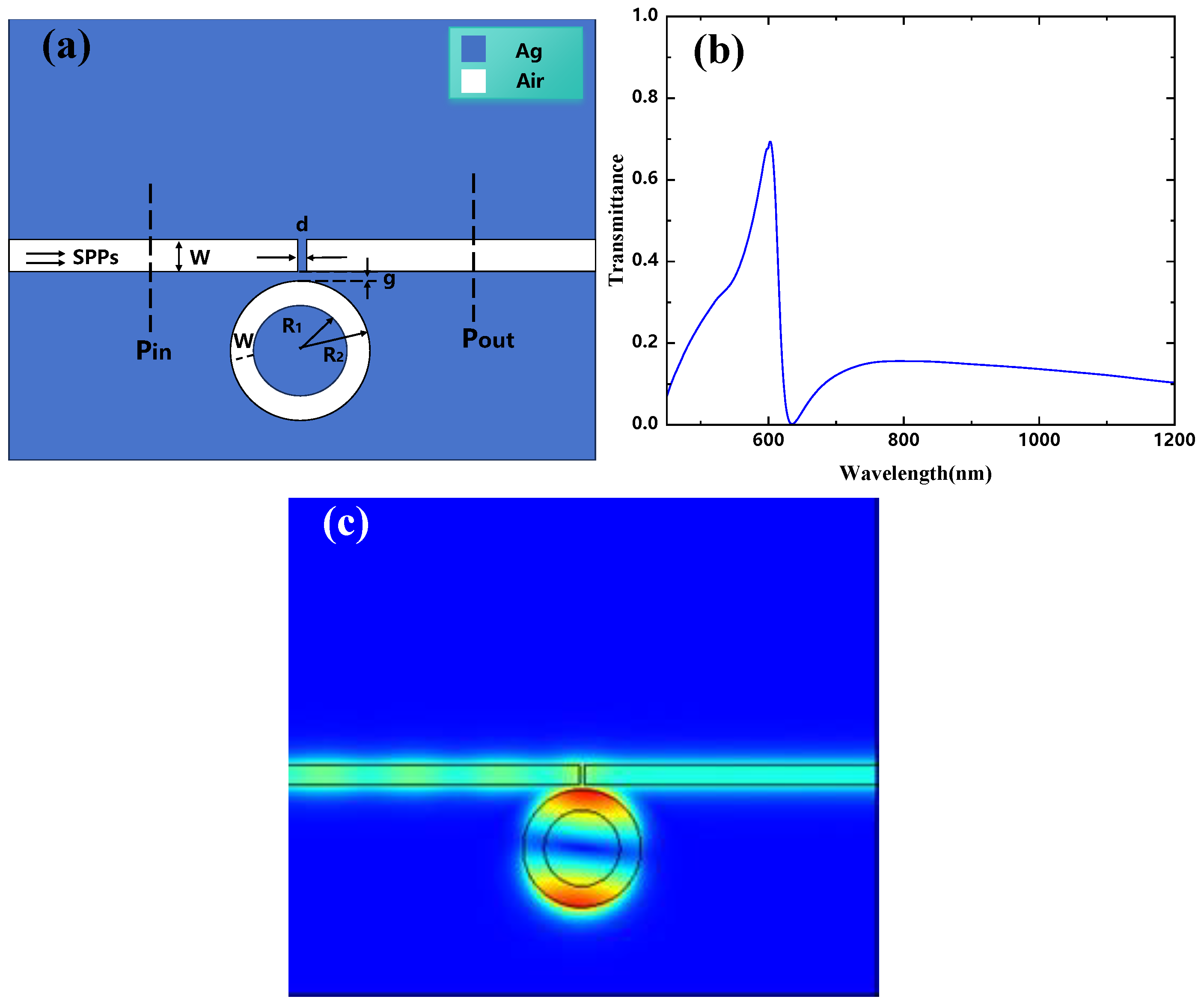


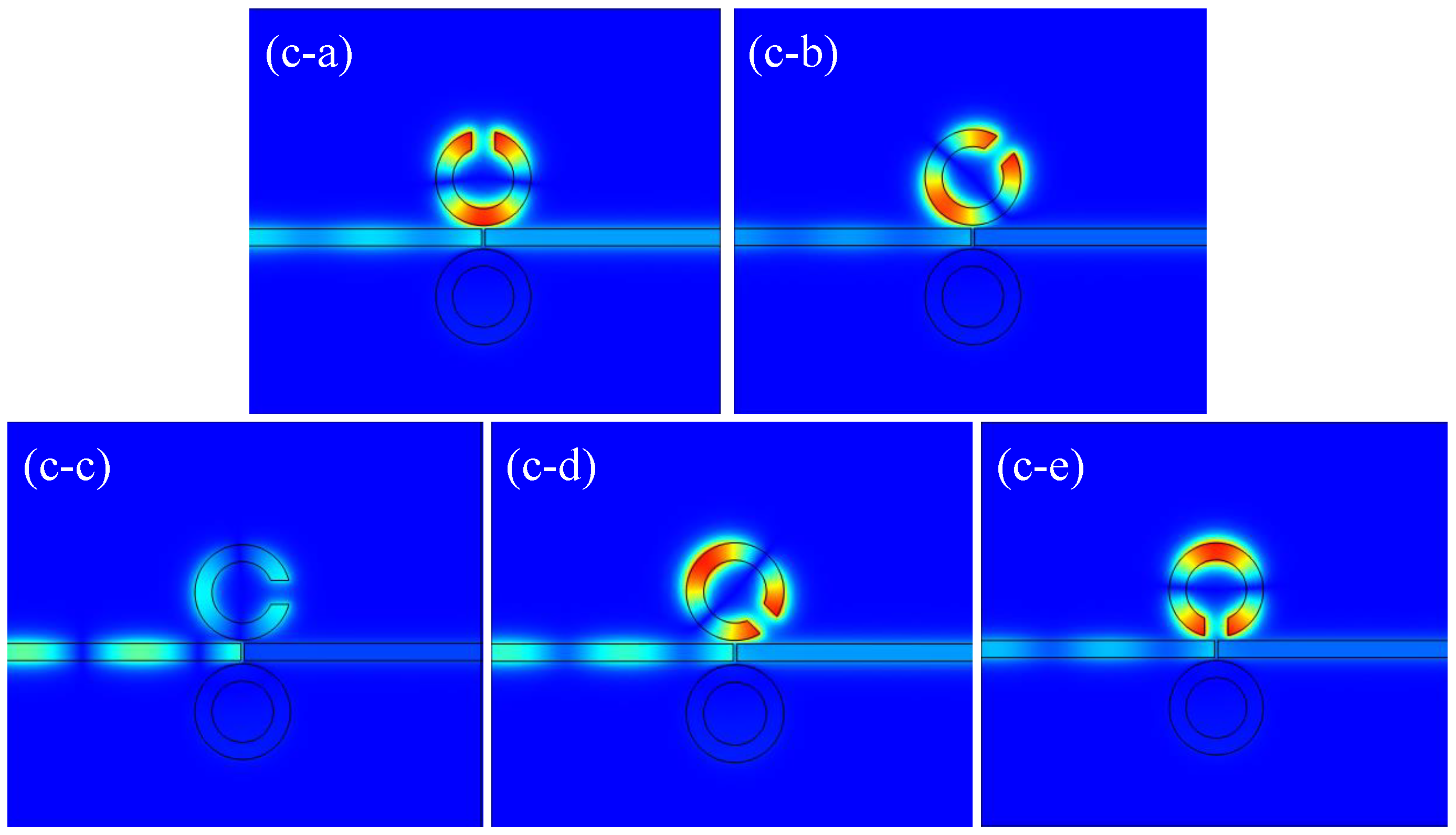
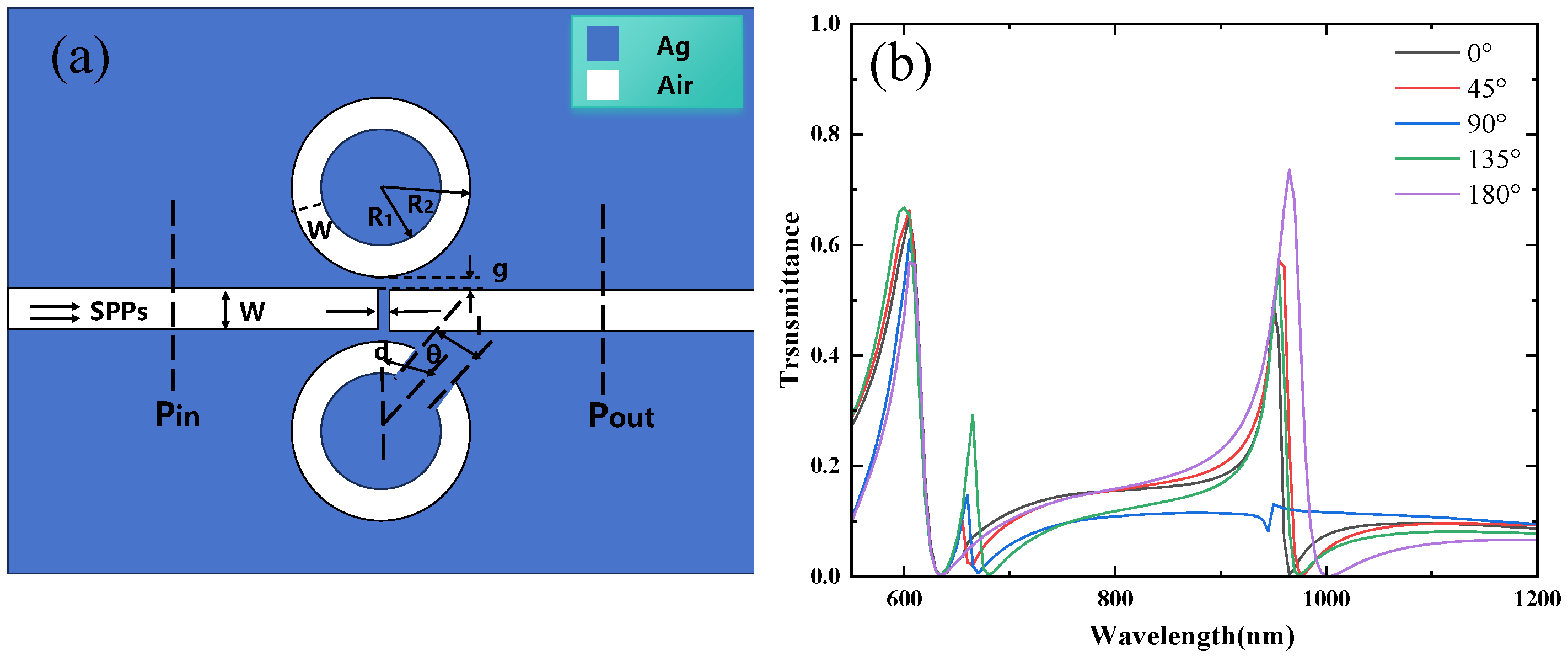

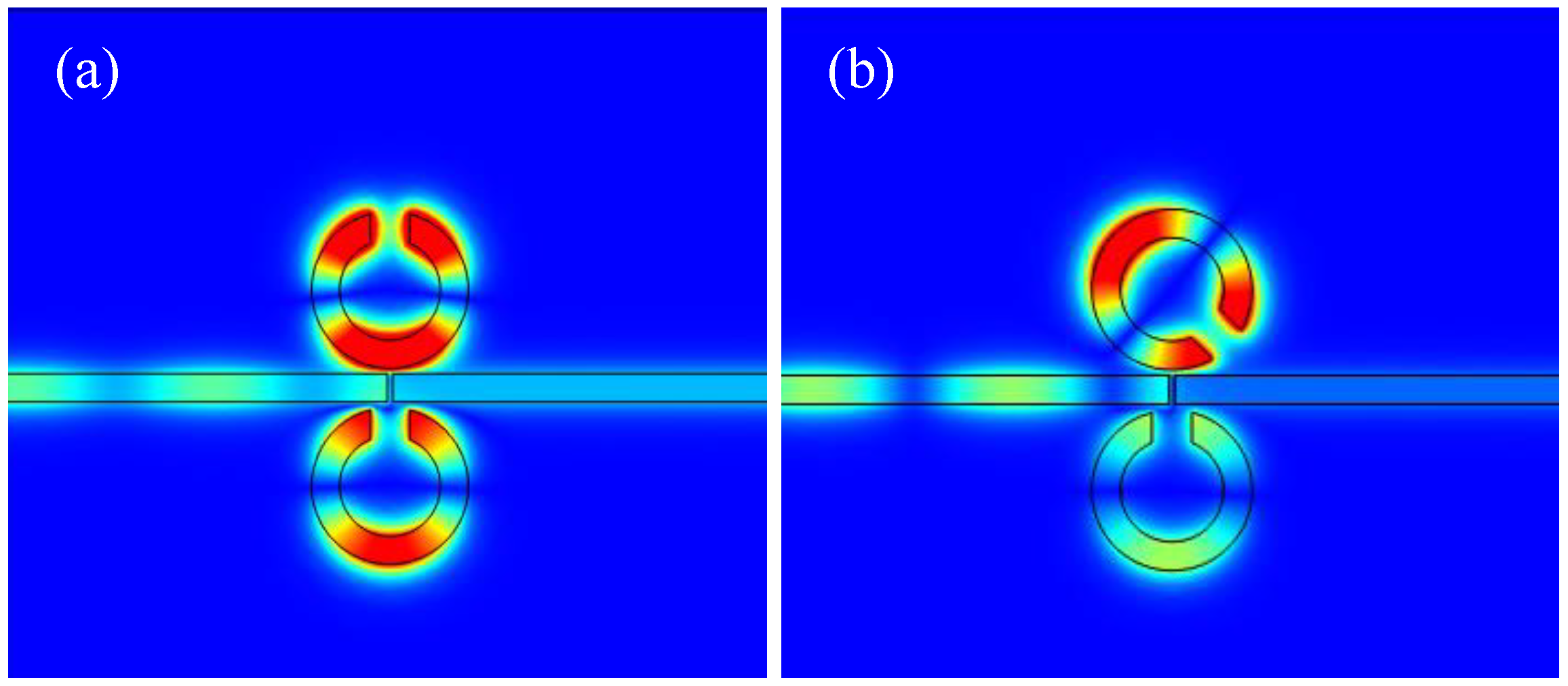
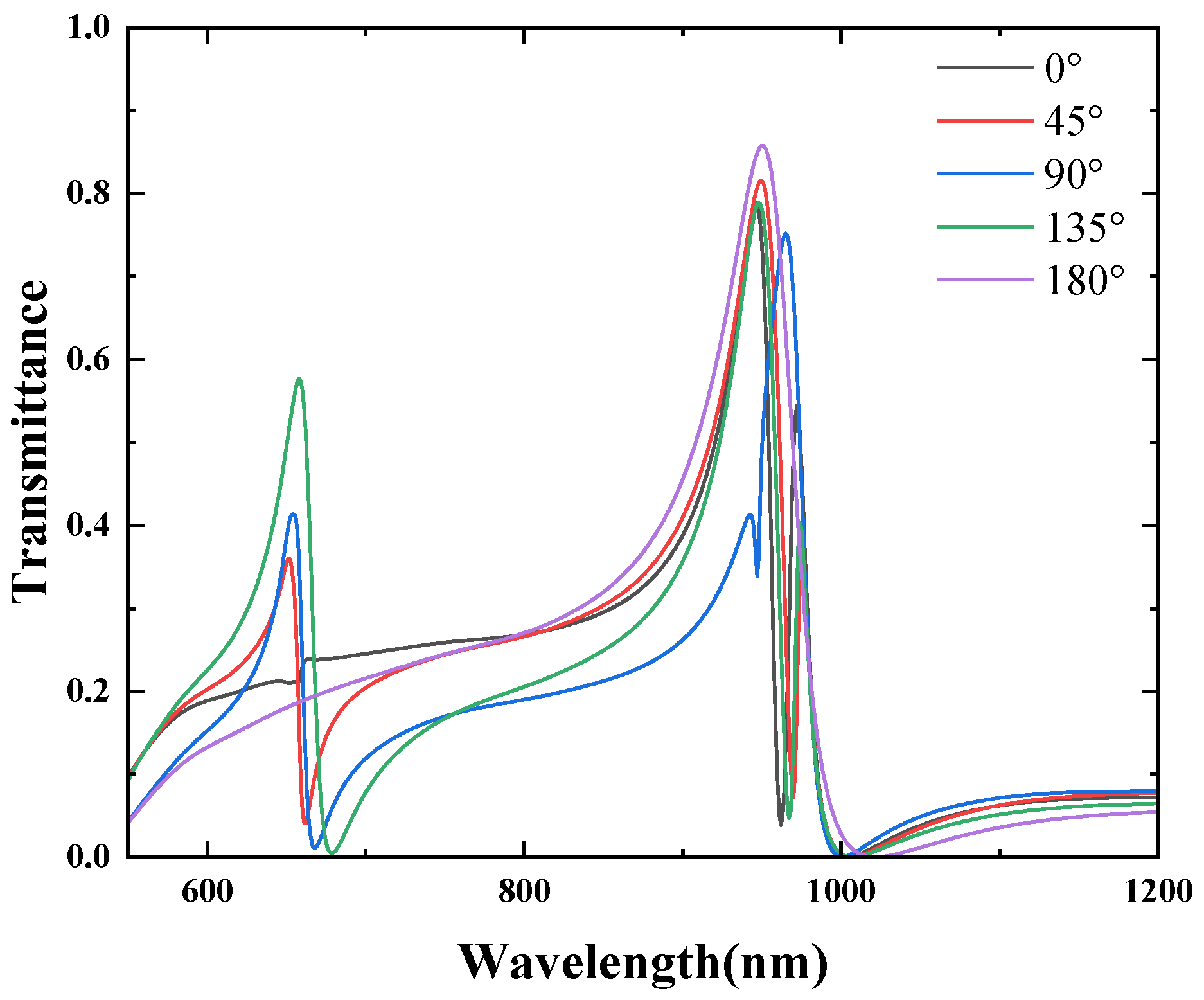
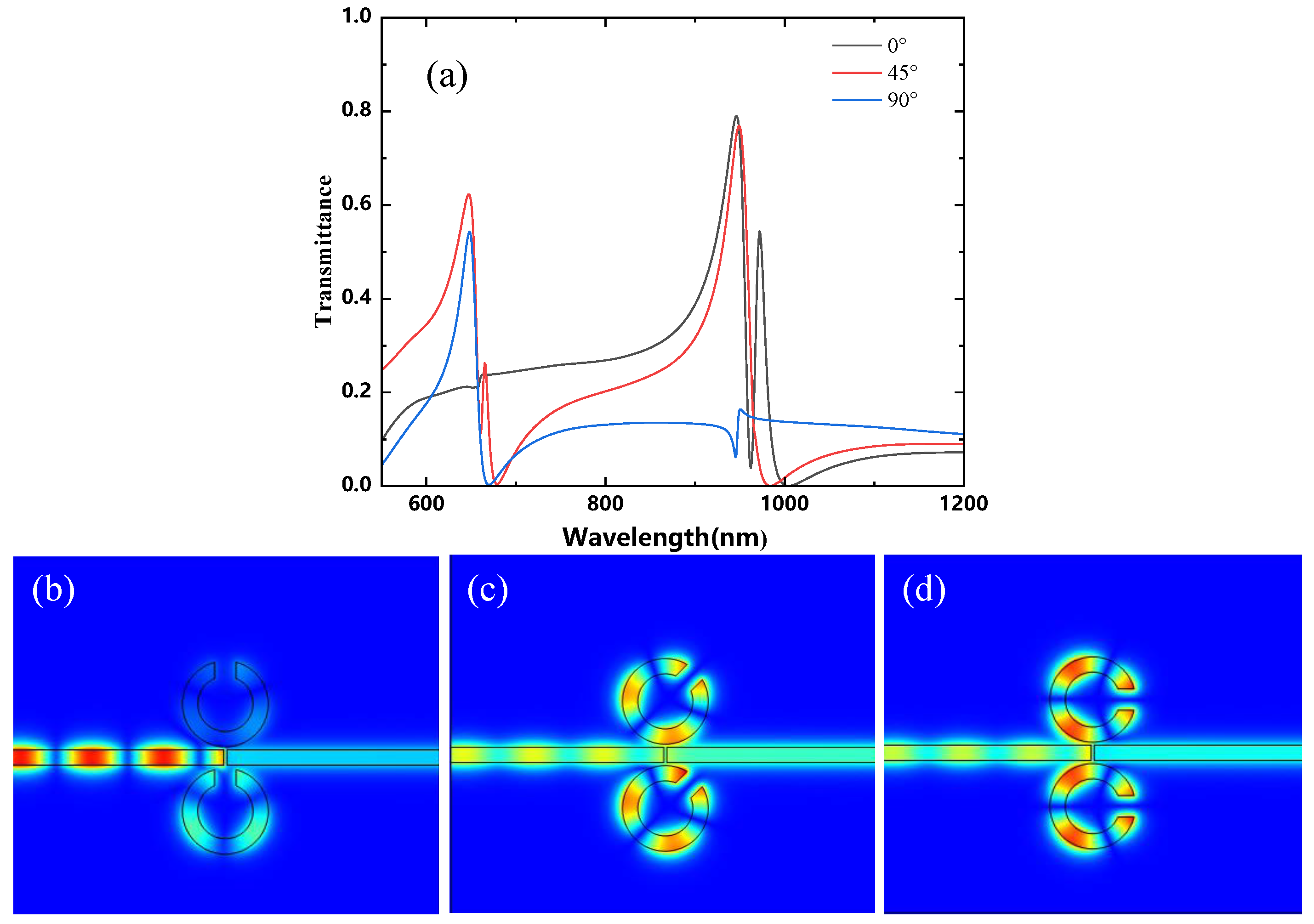

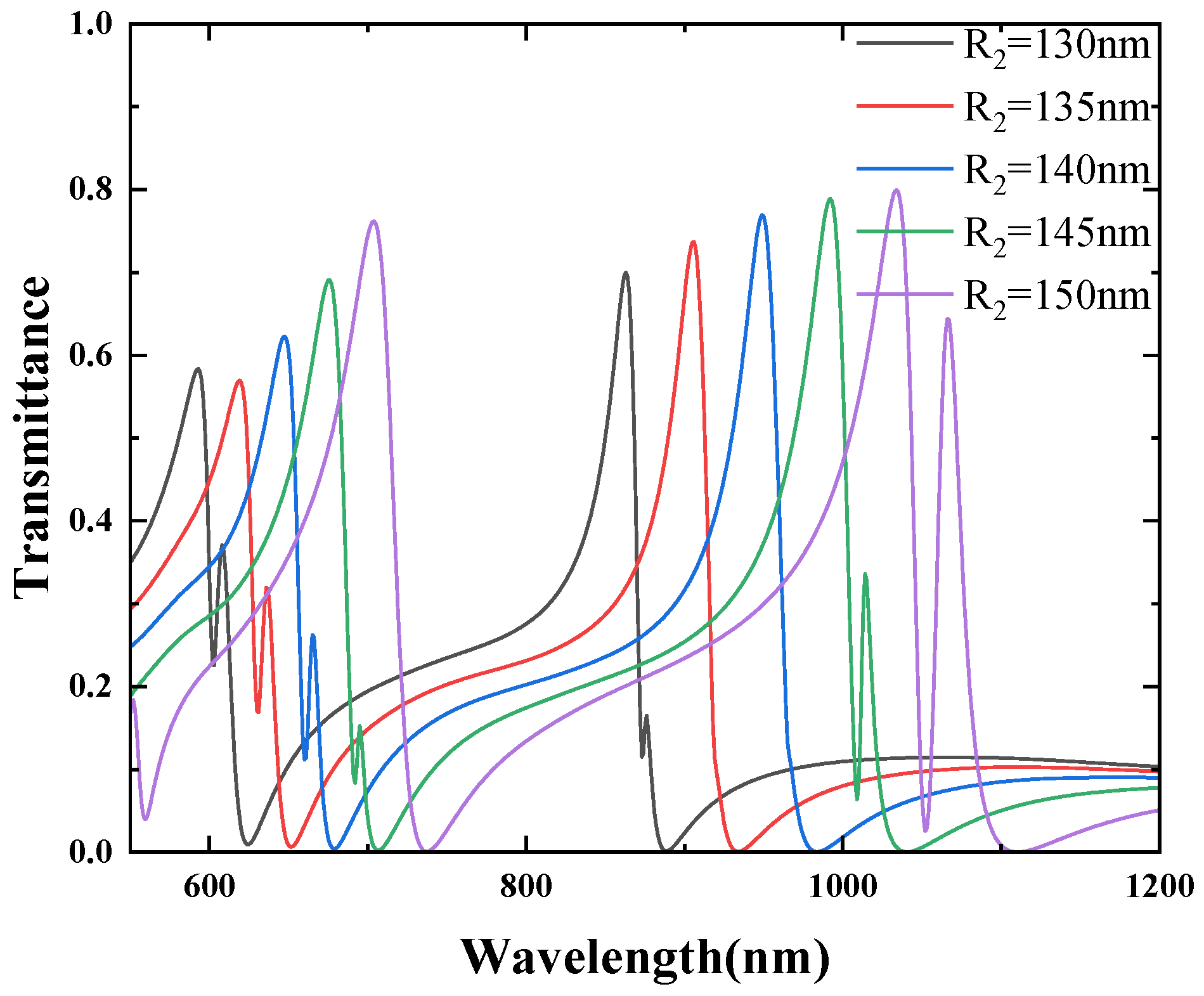
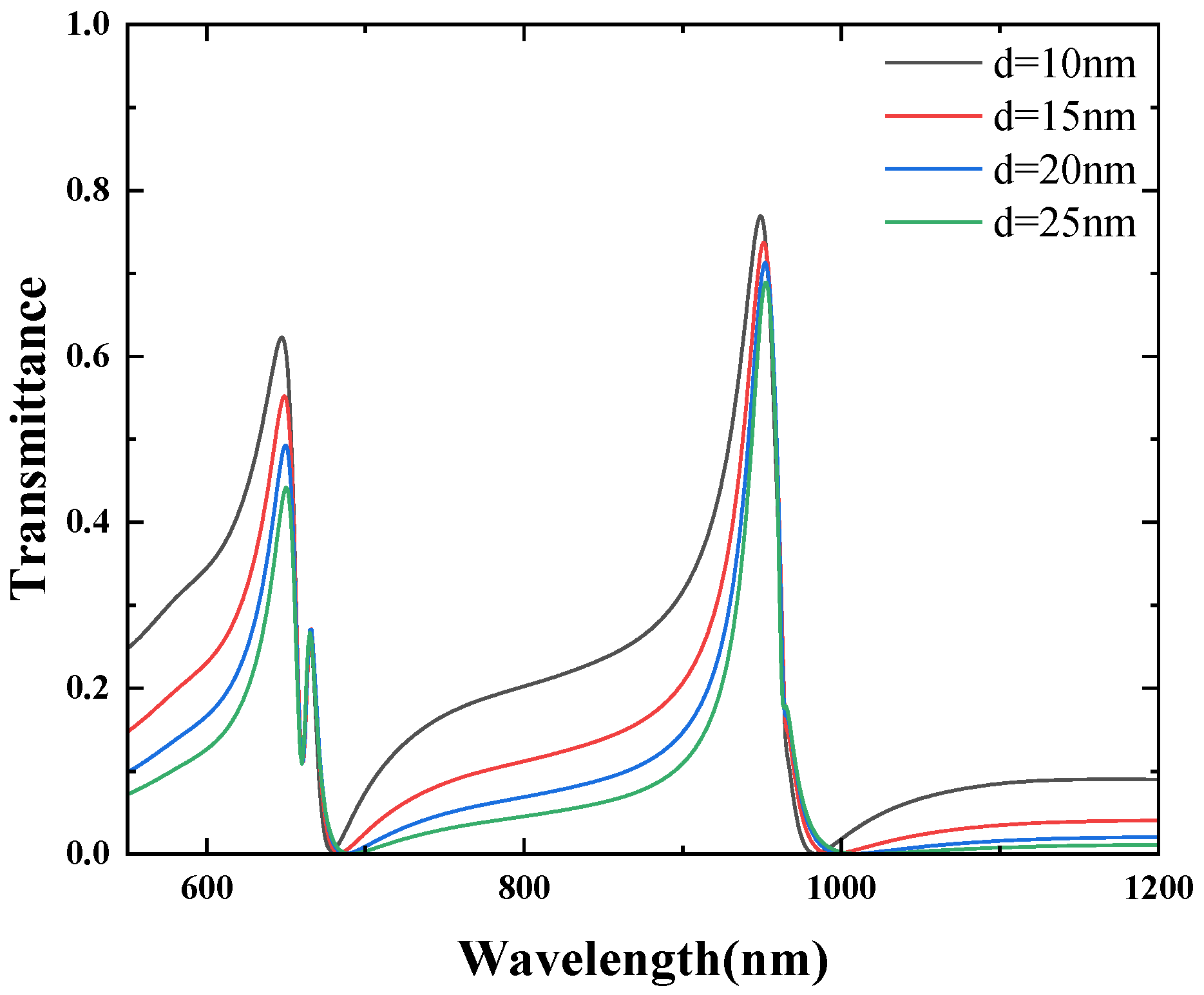

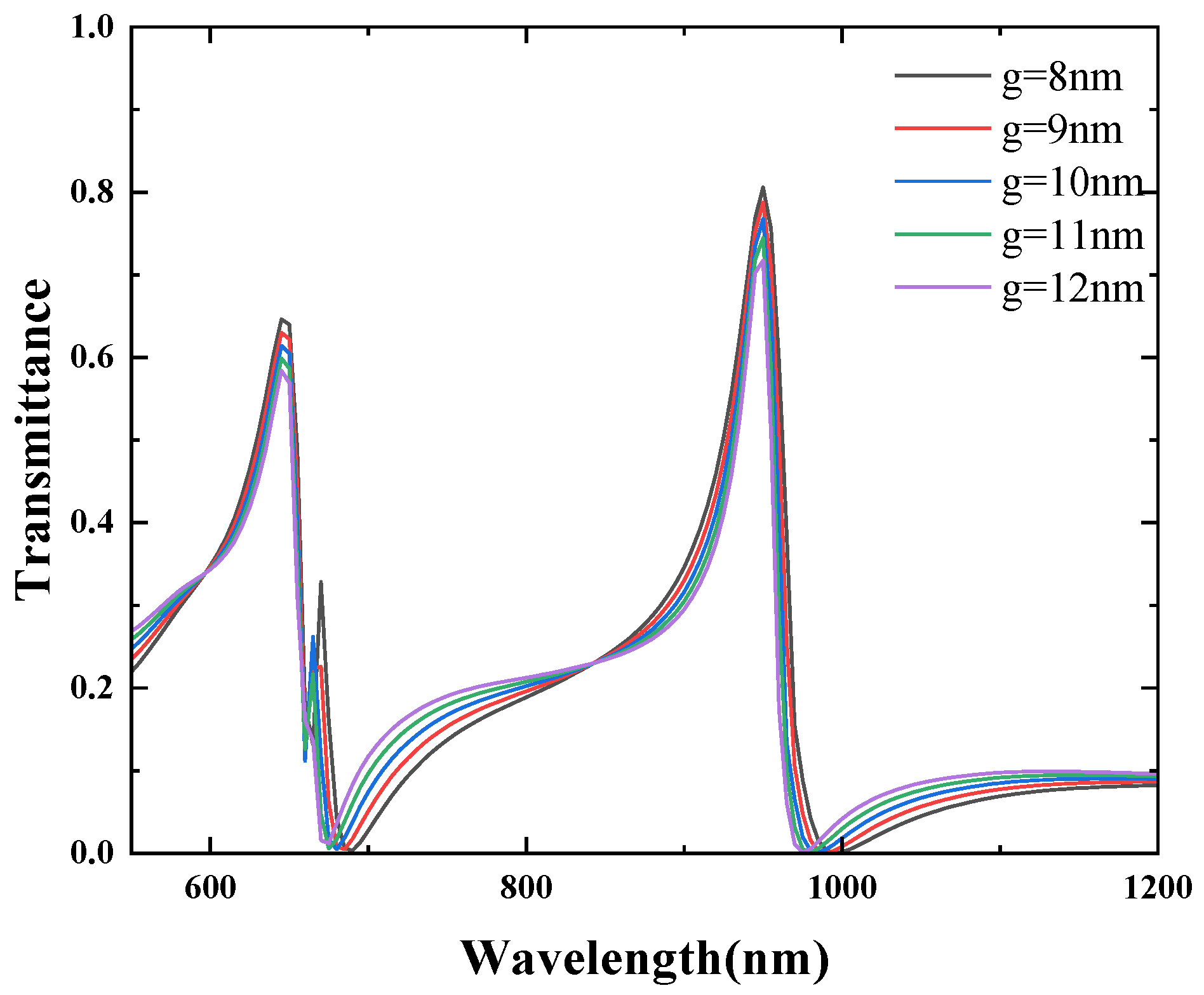
Disclaimer/Publisher’s Note: The statements, opinions and data contained in all publications are solely those of the individual author(s) and contributor(s) and not of MDPI and/or the editor(s). MDPI and/or the editor(s) disclaim responsibility for any injury to people or property resulting from any ideas, methods, instructions or products referred to in the content. |
© 2025 by the authors. Licensee MDPI, Basel, Switzerland. This article is an open access article distributed under the terms and conditions of the Creative Commons Attribution (CC BY) license (https://creativecommons.org/licenses/by/4.0/).
Share and Cite
Wang, W.; Zhang, S.; Cao, H. Fano Resonant Sensing in MIM Waveguide Structures Based on Multiple Circular Split-Ring Resonant Cavities. Micromachines 2025, 16, 183. https://doi.org/10.3390/mi16020183
Wang W, Zhang S, Cao H. Fano Resonant Sensing in MIM Waveguide Structures Based on Multiple Circular Split-Ring Resonant Cavities. Micromachines. 2025; 16(2):183. https://doi.org/10.3390/mi16020183
Chicago/Turabian StyleWang, Wenjing, Shaoze Zhang, and Huiliang Cao. 2025. "Fano Resonant Sensing in MIM Waveguide Structures Based on Multiple Circular Split-Ring Resonant Cavities" Micromachines 16, no. 2: 183. https://doi.org/10.3390/mi16020183
APA StyleWang, W., Zhang, S., & Cao, H. (2025). Fano Resonant Sensing in MIM Waveguide Structures Based on Multiple Circular Split-Ring Resonant Cavities. Micromachines, 16(2), 183. https://doi.org/10.3390/mi16020183







